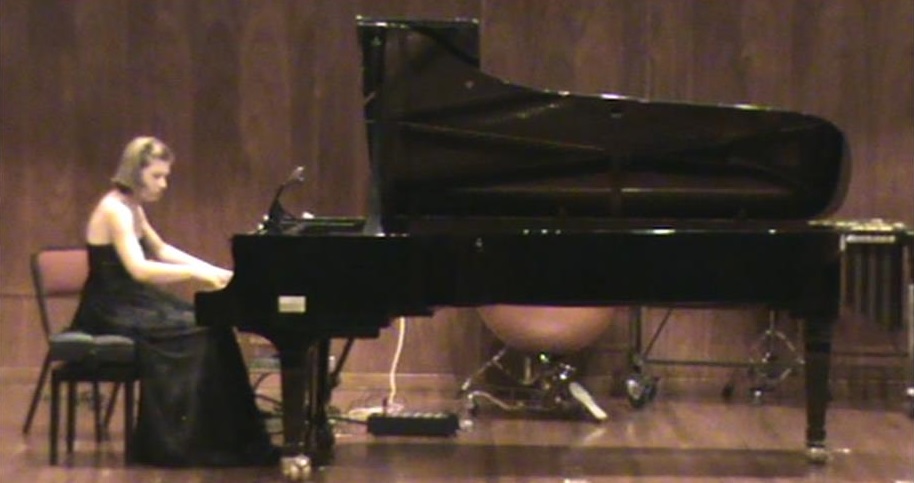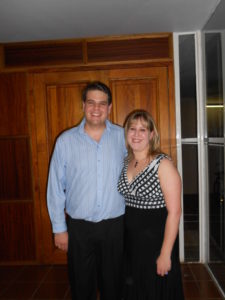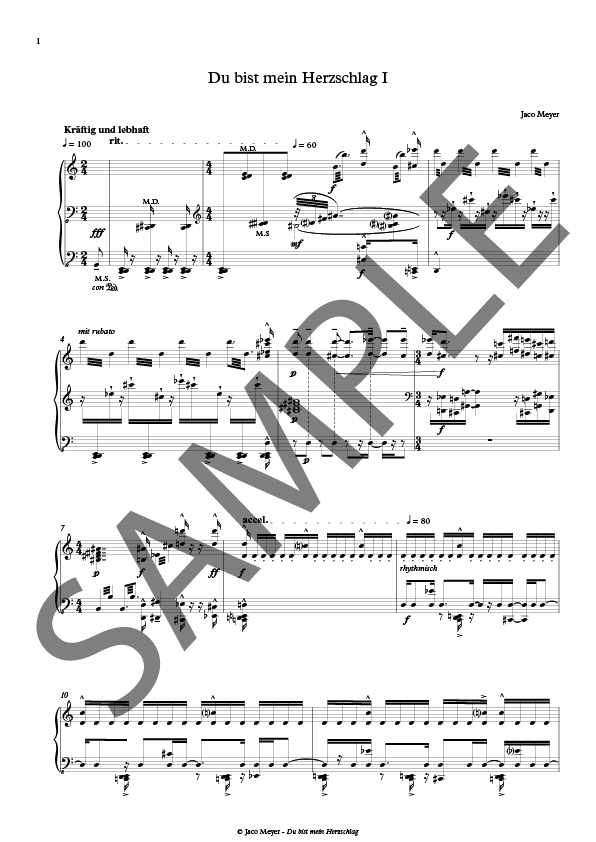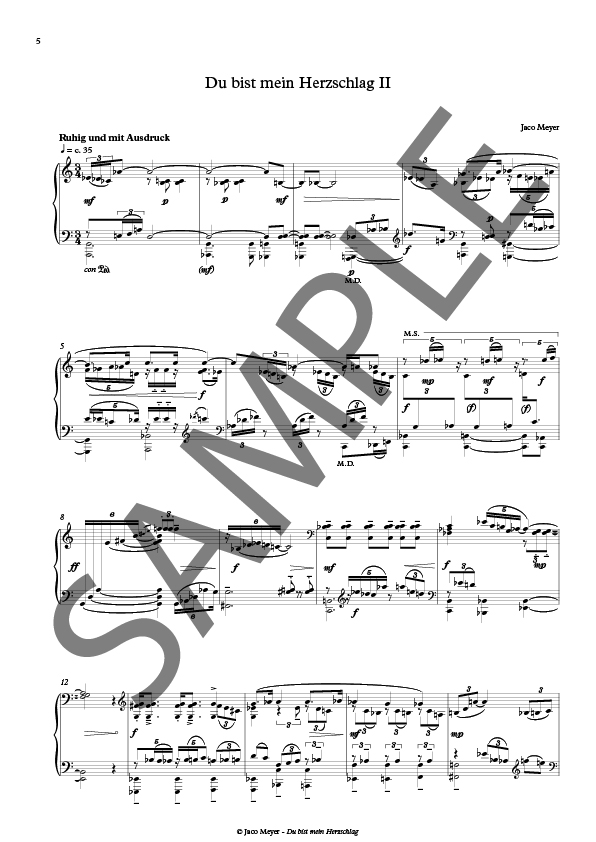
Du bist mein Herzschlag
for piano solo
Composition Details
Instrumentation | Piano |
Duration | c. 11′ |
Year of composition | 2012 |
Dedication | Fébé Meyer |
Movements
- Du bist mein Herzschlag I
- Du bist mein Herzschlag II
- Du bist mein Herzschlag III
Programme Notes
Du bist mein Herzschlag (‘You are my Heartbeat‘) for piano solo was inspired by a performance of Béla Bartók’s Out of Doors Suite (Sz. 81) by the Croatian pianist, Martina Filjak. This composition starts with percussive sounds where the very low clusters represent a heartbeat. These clusters that fall on different subdivisions of main beats and the irregular accents of the material are a mockery of a lover’s heart that goes out of rhythm. The tone D is the tonal centre of the composition and these clusters also mirror around D. The material that alternates with the clusters is mostly built from second and seventh chords of which the vertical intervals mirror around different pitch axes. The middle part of the composition is a slow and melodic segment which also contains certain elements of the previous material such as the seventh chords. The melody as well as the accompaniment becomes more dissonant and dense in texture to return to the clusters. I dedicated this composition to my fiancée (now my wife), Fébé Bruyns, to whom I refer in the title (“Du”).
Composer’s Statement
Du bist mein Herzschlag (‘You are my Heartbeat‘) for piano solo was inspired by a performance of Béla Bartók’s Out of Doors Suite (Sz. 81) by the Croatian pianist, Martina Filjak. This composition starts with percussive sounds where the very low clusters represent a heartbeat. These clusters that fall on different subdivisions of main beats and the irregular accents of the material are a mockery of a lover’s heart that goes out of rhythm. The tone D is the tonal centre of the composition and these clusters also mirror around D. The material that alternates with the clusters is mostly built from second and seventh chords of which the vertical intervals mirror around different pitch axes. The middle part of the composition is a slow and melodic segment which also contains certain elements of the previous material such as the seventh chords. The melody as well as the accompaniment becomes more dissonant and dense in texture to return to the clusters. I dedicated this composition to my fiancée (now my wife), Fébé Bruyns, to whom I refer in the title (“Du”).
Du bist mein Herzschlag I
The first movement of this composition consists mainly of two contrasting ideas where I attempt to use the piano to produce very percussive sounds on the one hand and also very melodic lines on the other hand. I start with the percussive sounds at the beginning where the very low clusters represent a heartbeat. These clusters that fall on different beats and the irregular accents of the material are a mockery of a lover’s heart that goes out of rhythm as well as an unidentifiable heart condition I have recently been diagnosed with which leads to dysrhythmia. The tone D is heard as the tonal center of the first movement and the clusters also mirror around D. The tonal center is also coloured extensively throughout the composition. The material that alternates with the clusters is mostly built from second and seventh chords of which the vertical intervals mirror around different pitch axes.
The middle part of the first movement is a slow and melodic segment which also contains certain elements of the previous material such as the seventh chords. The melody as well as the accompaniment becomes more dissonant and dense in texture to return to the clusters. The repeated Ds are now also heard in a lower register with the dissonant attacks above them. The melodic material is then also heard in the lower register until the clusters start again to prepare the listener for the climax of the composition at the end.
The first movement does not only explore the full range of the piano but also explores musical space and musical language as described by Cogan and Escot in their book The Nature of Sound and Music (1976). The performer is also challenged with complex rhythms and technical difficulties such as large stretches in order to play the intervals of which the largest is fourteen semitones. The change of hand positions and large jumps also contribute to the virtuosity of this composition.
Du bist mein Herzschlag II
The second movement of this composition is a direct contrast of the first movement in terms of tempo and expression, but it retains the idea of irregular beats and accents. It is a very slow and melodic movement which explores chromatic harmonies and the crossing of the hands in order to achieve multiple musical lines. The fundamental patterns and ideas are introduced at the beginning of the movement and these are used in various permutations and set class techniques in the remainder of the movement.
The thin texture of this movement becomes denser as melodic lines are added towards the end of the movement. This movement mainly explores the technical abilities of performers to continuously cross their hands and play several melodic lines at once.
Du bist mein Herzschlag III
The third movement of the composition is a toccata-like movement. In this movement I chose short arpeggiated musical gestures to contrast abrupt cluster chords, not only as a technical challenge for performers but also as a way to construe musical structure in the movement. I wanted to retain the idea of clusters, like in the first movement, but chose to treat the clusters differently in this movement. From a more metaphoric perspective this movement can be perceived as the irregular palpitations of the lover’s heart.
An interesting play can be perceived between the white and the black keys of the piano in this movement, and the mirroring of tones is more on a horizontal level here than a vertical level like in the first movement. This movement can be perceived as an unraveling of all the complex patterns and musical gestures of the previous two movements, but at the end of the composition the material returns to clusters and end on a dissonant cluster chord – more dissonant and ominous than the very first clusters of the composition.
Recordings
Performances
23 October 2012. South African Music Concert, School of Music and Conservatory, North-West University, Potchefstroom, South Africa. Rachelle Elmes-Wessels (Piano).
Media


Rachelle Elmes-Wessels performing Du bist mein Herzschlag at the South African Music Concert 2012
Jaco and Fébé Meyer at the South African Music Concert 2012
Music Score
The music score of this composition can be ordered from the composer through the contact page. Please ensure that you provide the correct title and version/instrumentation of the composition that you would like to order.

